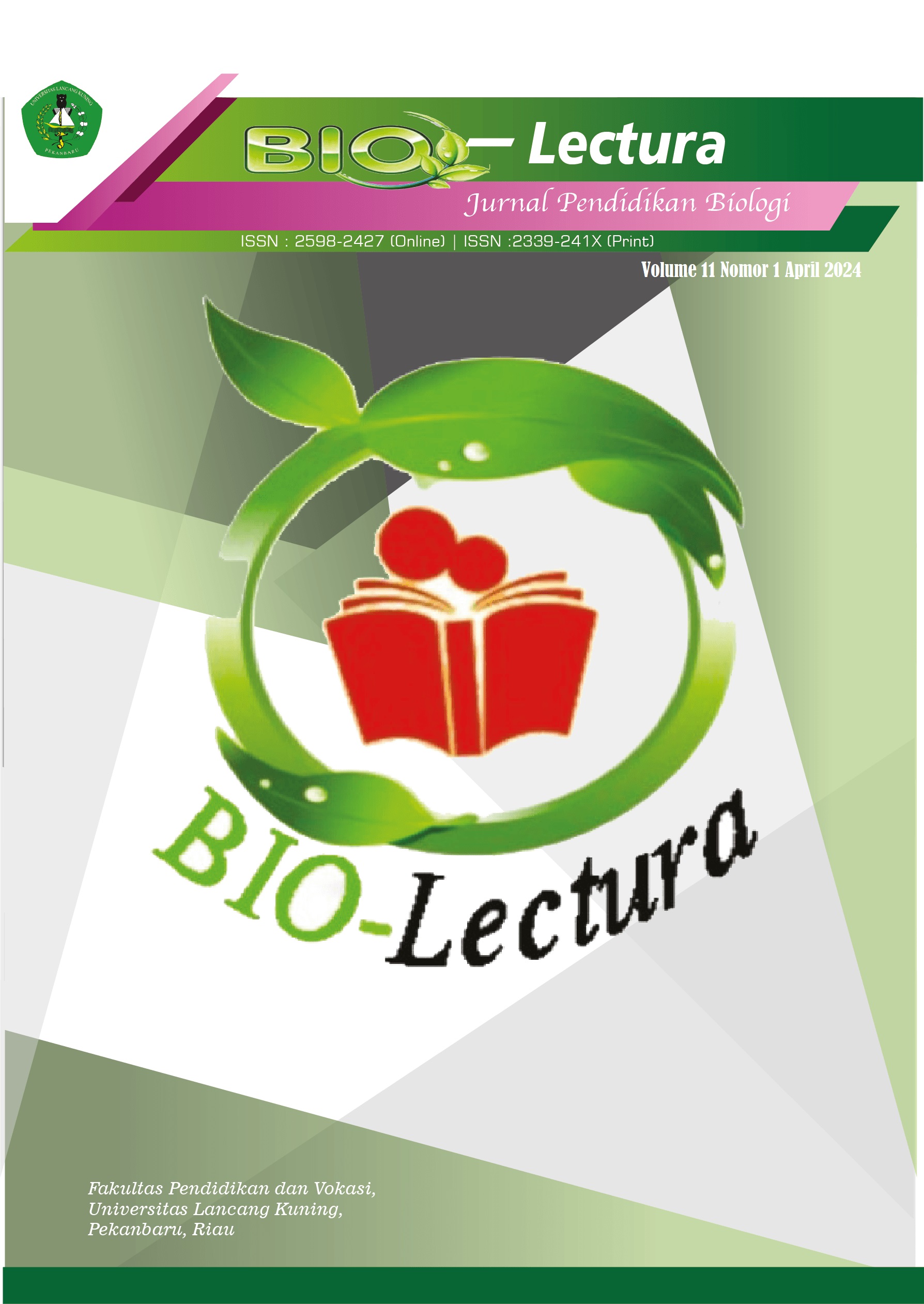KARAKTERISASI DAN POTENSI BAKTERI ENDOFIT AKAR KOPI (Coffea sp) SEBAGAI PENGHASIL INDOLE ACETIC ACID (IAA)
Abstract
The Endophytic bacteria as a biofertilizer agent can minimize the use of chemicals from synthetic fertilizers. The aim of this research was to study the density, diversity and ability of endophytic bacteria from coffee plants that have the potential to produce IAA. Root samples were obtained from coffee plants in UB Forest (UBF), Sumberwangi, Malang. The root samples were surface sterilized and then crushed with a blender. Endophytic bacteria were isolated and tested for their potential to produce IAA. The results obtained were 18 isolates of IAA-producing bacteria. KAA6 Isolate were produced the highest concentration of IAA of 10.73 ppm at 48 hours of incubation followed by KBA3 isolate which produced 12.78 ppm of IAA at 72 hours of incubation. The potential bacteria can be further optimized to be used as an eco-friendly biofertilizer agent.
Downloads
References
Ayelign, A., & Sabally, K. 2013. Determination of Chlorogenic Acids (CGA) in Coffee Beans using HPLC. American Journal of Research Communication, 1(2), 78–91. www.usa-journals.comwww.usa-journals.com,
Bunga Hutamy, H., & Nuraini, Y. 2019. Diversity and Population of Phosphate Solubilizing Bacteria in Various Land Uses at UB Forest. Jurnal Tanah Dan Sumberdaya Lahan, 06(01), 1113–1122. https://doi.org/10.21776/ub.jtsl.2019.006.1.10
Caldwell, A. C., Silva, L. C. F., Da Silva, C. C., & Ouverney, C. C. 2015. Prokaryotic diversity in the rhizosphere of organic, intensive, and transitional coffee farms in Brazil. PLoS ONE, 10(6), 1–17. https://doi.org/10.1371/journal.pone.0106355
Fadhilah Israwan, R., Ardyati, T., Biologi, J., & Matematika dan Ilmu Pengetahuan Alam, F. 2015. Eksplorasi Bakteri Pemfiksasi Nitrogen Non Simbiotik Penghasil IAA dan Pelarut Fosfat Asal Rhizosfer Tanaman Apel Kota Batu, Jawa Timur. Jurnal Biotropika |, 3(2), 55.
Gang, S., Sharma, S., Saraf, M., Buck, M., & Schumacher, J. 2020. Analysis of Indole-3-acetic Acid (IAA) Production in Klebsiella by LC-MS/MS and the Salkowski Method. Journal of Food Legumes, 33(3), 181–190. https://doi.org/10.21769/BioProtoc.3230
Hardoim, P. R., van Overbeek, L. S., Berg, G., Pirttilä, A. M., Compant, S., Campisano, A., Döring, M., & Sessitsch, A. 2015. The Hidden World within Plants: Ecological and Evolutionary Considerations for Defining Functioning of Microbial Endophytes. Microbiology and Molecular Biology Reviews, 79(3), 293–320. https://doi.org/10.1128/mmbr.00050-14
Herlina, L., Pukan, K. K., & Mustikaningtyas, D. 2017. The endophytic bacteria producing IAA (Indole Acetic Acid) in Arachis hypogaea. Cell Biology and Development, 1(1), 31–35. https://doi.org/10.13057/cellbioldev/v010106
Kandel, S. L., Firrincieli, A., Joubert, P. M., Okubara, P. A., Leston, N. D., McGeorge, K. M., Mugnozza, G. S., Harfouche, A., Kim, S. H., & Doty, S. L. 2017. An in vitro study of bio-control and plant growth promotion potential of salicaceae endophytes. Frontiers in Microbiology, 8(MAR). https://doi.org/10.3389/fmicb.2017.00386
Kim, B. R., Shin, J., Guevarra, R. B., Lee, J. H., Kim, D. W., Seol, K. H., Lee, J. H., Kim, H. B., & Isaacson, R. E. 2017. Deciphering diversity indices for a better understanding of microbial communities. Journal of Microbiology and Biotechnology, 27(12), 2089–2093. https://doi.org/10.4014/jmb.1709.09027
McCauley, A., Jones, C., & Olson-Rutz, K. 2017. Soil pH and Organic Matter. Encyclopedia of Soil Science, Second Edition, 8, 1–16. https://doi.org/10.1201/noe0849338304.ch253
McLaughlin, J. E., McLaughlin, G. W., McLaughlin, J. S., & White, C. Y. 2016. Using Simpson’s diversity index to examine multidimensional models of diversity in health professions education. International Journal of Medical Education, 7, 1–5. https://doi.org/10.5116/ijme.565e.1112
Mma, Y., & Mfm, E. 2014. Biofertilizers and their role in management of plant parasitic nematodes. A review. E3 Journal of Biotechnology and Pharmaceutical Research, 5(1), 1–6. http://www.e3journals.org
Moore, V. 2013. The Environmental Impact of Coffee Production: What’s Your Coffee Costing The Planet? https://www.sustainablebusinesstoolkit.com/environmental-impact-coffee-trade/
Napitupulu, T. P., Kanti, A., & Sudiana, I. M. 2019. Evaluation of the Environmental Factors Modulating Indole-3-acetic Acid (IAA) Production by Trichoderma harzianum InaCC F88. IOP Conference Series: Earth and Environmental Science, 308(1). https://doi.org/10.1088/1755-1315/308/1/012060
Oliveira, M. N. V., Santos, T. M. A., Vale, H. M. M., Delvaux, J. C., Cordero, A. P., Ferreira, A. B., Miguel, P. S. B., Tótola, M. R., Costa, M. D., Moraes, C. A., & Borges, A. C. 2013. Endophytic microbial diversity in coffee cherries of coffea arabica from southeastern Brazil. Canadian Journal of Microbiology, 59(4), 221–230. https://doi.org/10.1139/cjm-2012-0674
Peiffer, J. A., Spor, A., Koren, O., Jin, Z., Tringe, S. G., Dangl, J. L., Buckler, E. S., & Ley, R. E. 2013. Diversity and heritability of the maize rhizosphere microbiome under field conditions. Proceedings of the National Academy of Sciences of the United States of America, 110(16), 6548–6553. https://doi.org/10.1073/pnas.1302837110
Pratiwi, E. R., Ardyati, T., & Suharjono, S. 2020. Plant Growth Promoting Endophytic Bacteria of Coffea canephora and Coffea arabica L. in UB Forest. The Journal of Experimental Life Sciences, 10(2), 119–126. https://doi.org/10.21776/ub.jels.2020.010.02.07
Roswell, M., Dushoff, J., & Winfree, R. 2021. A conceptual guide to measuring species diversity. Oikos, 130(3), 321–338. https://doi.org/10.1111/oik.07202
Suharjono, & Yuliatin, E. 2022. Bacteria communities of coffee plant rhizosphere and their potency as plant growth promoting. Biodiversitas, 23(11), 5822–5834. https://doi.org/10.13057/biodiv/d231136
Xa, L. T., Nghia, N. K., & Tecimen, H. B. 2022. Environmental Factors Modulating Indole-3-Acetic Acid Biosynthesis by Four Nitrogen Fixing Bacteria in a Liquid Culture Medium. Environment and Natural Resources Journal, 20(3), 279–287. https://doi.org/10.32526/ennrj/20/202100233
Copyright (c) 2024 Bio-Lectura : Jurnal Pendidikan Biologi

This work is licensed under a Creative Commons Attribution-ShareAlike 4.0 International License.
- You do not have to comply with the license for elements of the material in the public domain or where your use is permitted by an applicable exception or limitation.
- No warranties are given. The license may not give you all of the permissions necessary for your intended use. For example, other rights such as publicity, privacy, or moral rights may limit how you use the material.












